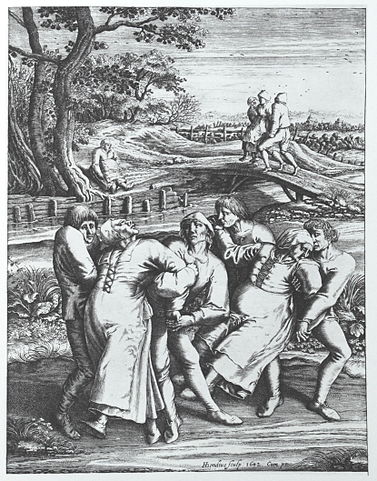
What was the dancing plague of 1518? The dancing plague of 1518 happened in Strasbourg, France, and up to 400 people couldn’t stop dancing for several weeks. It is said that many people died of exhaustion.
Everything is said to have started in July 1518, in a town called Strasbourg, which is now in France, but was in Alsace at the time. A woman called Frau Troffea began to dance in a central square. She had no musical accompaniment and just danced to her own rhythm. People clapped along with her, but when she didn’t stop, they realized it was something more. Frau Troffea danced for 6 days and nights without pausing. In the beginning, people only watched, but then others began to join in and dance to their own beat. More and more people joined until there were hundreds. They danced all through July, all through August, and into early September. By mid September, the dancers had stopped. People danced without stopping, without food, and without sleep. It is said that at the peak of the dancing plague 15 people a day died from exhaustion and heart attacks. Overall, hundreds of people died before the plague subsided.
The first question is whether or not this actually happened. It did happen. There are documents that record the event from the time that still survive. There are notes from physicians, written copies of sermons given in cathedrals, regional histories that mention it, and some notes left by the city council of Strasbourg. There is no doubting that the event happened. However, there are no records of people having died. Even the Strasbourg city council, which would be the most likely to record any deaths if they had happened, doesn’t make any mention of them. All of the records of people dying come from accounts of the event written years later. There are no contemporary accounts of people dying.
So, what could have caused it? There are several theories that have risen up. At the time, people thought it could have been demon possession. It was also a very hot summer and another theory was that it was overheated blood. A modern theory is that the dancing was produced by some kind of fungal infection. There is a mold that grows in damp rye called ergot. Ergot is a fungus that produces ergotamine, which is what LSD was originally synthesized from. If bread is made with the ergot infected rye, the mold will be baked into the bread and people can consume it. Being a psychedelic drug, ergot can cause severe hallucinations, seizures, and is fatal in large doses. The seizures could have been mistaken for dancing and the deaths could have been caused by the drug. However, it kills quickly and seizures last for minutes, not for days. So, if it wasn’t chemical, what was it?
Another theory, and probably a more likely one, is that it was simply a case of mass-hysteria. 1518 was the tail end of a series of disasters that had befallen Strasbourg. There had been numerous poor harvests due to hot weather and low rainfall. This had driven up the price of grain. Leprosy had reared its ugly head, along with smallpox and syphilis outbreaks. The bubonic plague had returned for a while. Many people were sick and many more people were starving. People in that frame of mind are very susceptible to suggestion and more people in the 16th century were religious than they are these days. The theory is that people were overly stressed by all of these events and they were led to believe that more would befall them. Many people were also led to believe that St. Vitus, a Catholic saint and the saint of dancing, had cursed them to misery and to dance. It could be that one person (perhaps this Frau Troffea, perhaps not) started to dance, claiming that she was cursed, and the dancing just spread across a susceptible and stressed population. This was certainly not the first dancing plague and also not the last. There have been several other incidences of it happening. If people thought that something like this had happened before, it would make it even easier for them to believe and to dance. Hysteric events like this feed themselves because the more people that dance, the more people that believe and start to dance.
It seems inarguable that this happened and that hundreds of people danced. It also seems likely that it was mass-hysteria brought on by too much hardship. However, it doesn’t seem likely that hundreds of people died. It is not impossible for people to die while hysterical, but if they had, there would certainly be records of it. The story was most likely exaggerated after the fact. And this is what I learned today.
Try these next:
Sources
https://www.euppublishing.com/doi/10.3366/drs.2017.0199
https://www.britannica.com/event/dancing-plague-of-1518
https://www.history.com/articles/what-was-the-dancing-plague-of-1518
https://www.bbc.com/culture/article/20220512-the-people-who-danced-themselves-to-death
https://en.wikipedia.org/wiki/Dancing_plague_of_1518
https://www.bbc.com/future/article/20161028-the-town-the-nearly-danced-itself-to-death
https://bigthink.com/the-past/dancing-plague-middle-ages
Image By Pieter Brueghel the Elder – Pieter Bruegel d. Ä. – Das gesamte graphische Werk. Wien-München: Schroll [o. J.], Abb. Nr. 124 (Scan durch H.-P.Haack, Leipzig), Public Domain, https://commons.wikimedia.org/w/index.php?curid=3307982
